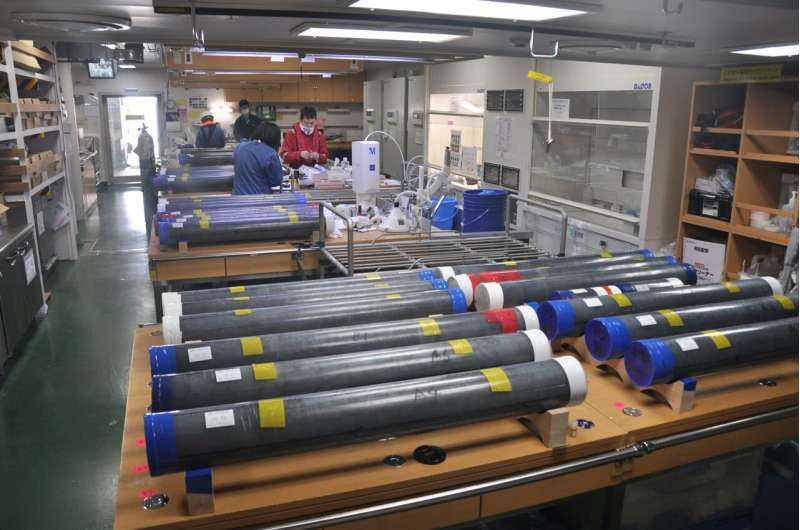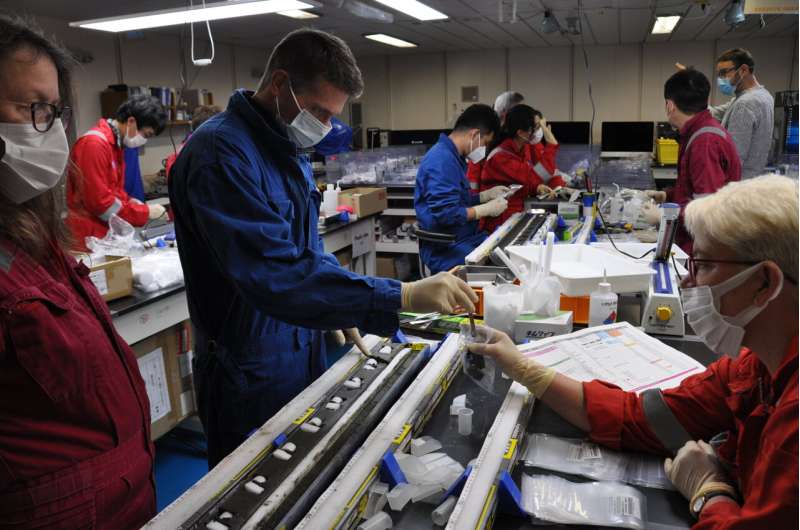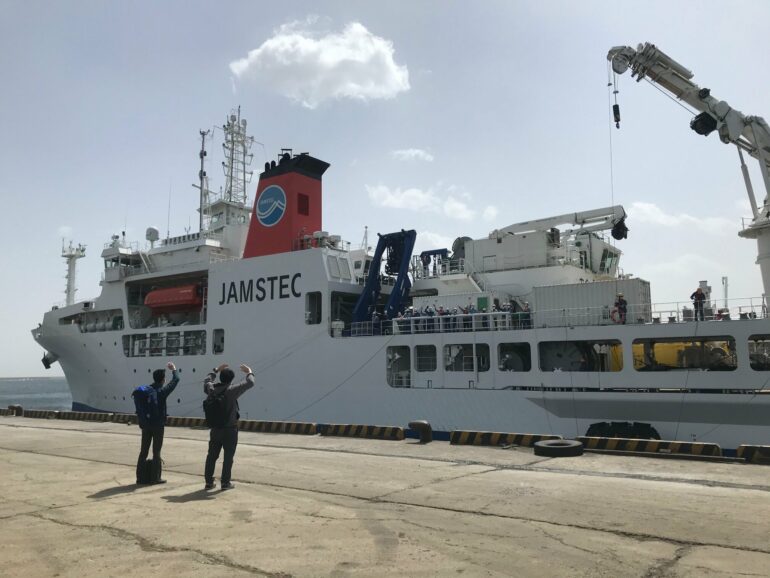The Japan Trench is located on the “Pacific Ring of Fire,” a region of special interest in earthquake and deep-water research.
“It is here that oceanic plates bend, form ultra-deep-water trenches and move below overriding plates in so-called subduction zones, while accumulating long-term global plate tectonic strain,” says Dr. Ken Ikehara from National Institute of Advanced Industrial Science and Technology, Japan, and co-chief scientist of IODP Expedition 386. “This energy is released cataclysmically during so-called megathrust earthquakes, like it happened in 2011 during the devastating Tohoku-oki Earthquake.”
Earthquake-related seafloor deformation and shaking can remobilize large amounts of sediments and fresh organic carbon that is subsequently transferred by gravity flows into the terminal sink of hadal trench basins. In order to study the long-term history of megathrust earthquakes and investigate the roles of earthquakes in the ultra-deep-water environment, the IODP Expedition 386 team has collected and analyzed 58 sediment cores taken from holes cored up to 37.82 meters deep in the sea bed at 15 sites along the 500-km-long trench axis.
“These operational expedition achievements of successful deep-subsurface sampling at water depths between 7,445 and 8,023 m below sea level set two new records in over 50 years of scientific ocean drilling and coring,” says Prof. Michael Strasser from the University of Innsbruck and co-chief scientist of the IODP Expedition 386. “We have cored the deepest water site at a water depth of 8,023 meters and recovered the deepest sub-sea level sample from 8,060.74 meters below sea level.”
Analysis of such unprecedented samples and research led by Prof. Rui Bao at Ocean University of China has found a large amount of labile dissolved carbon stored in the sediment interstitial water. The dissolved carbon storage implies active organic carbon remineralization in the hadal trenches that is much greater than in other deep-water environments of the open ocean. Using advanced radiocarbon techniques, the team discovered aging and accumulation of the dissolved organic and inorganic carbon in the deep subsurface sediments.
“These are exciting results, because these dissolved carbon fractions may have great impacts on the deep carbon cycle as they are buried still deeper into the trench sediments and the subduction zone,” said Mengfan Chu, Ph.D. candidate at Ocean University of China, and lead-author of the study now published in Nature Communications.

The core samples collected from the Japan Trench on R/V Kaimei. © ECORD/IODP/JAMSTEC
Active microbial-mediated dissolved carbon cycling in the deep subsurface sediments
A comprehensive geochemistry investigation on the sediment interstitial water based on IODP Expedition 386 results supports the hypothesis. Huge storages of methane are found in sediments along the whole Japan Trench, together with other outstanding geochemical characteristics of the interstitial water.
This points to intensive microbial methanogenesis in the hadal trenches and is interpreted as an enhancement effect of repeated large earthquakes along the subduction zone. Through increasing organic carbon fluxes and regulating the physical and chemical characteristics of the sediment deposits, earthquakes serve as a powerful modulator in the trench carbon cycle and the deep biosphere metabolisms in these extreme environments.
“These discoveries provide strong evidence that the hadal trenches are not ‘tranquil’ deep-sea environments as previously considered. We’re excited to say that more discoveries about the hadal trench carbon cycle are bound to be made in the future.” says Prof. Rui Bao.
“For instance, in our study we also report the occurrence of authigenic carbonates in the deep subsurface of Japan Trench sediments, which suggests active transformation of carbon between its different forms (sedimentary, dissolved, gaseous and mineral) and implies that hadal trench environments host dynamic carbon cycling, which link the Earth’s surface and its deeper interior along subduction zones, providing great opportunities for future studies,” Prof. Bao continues.

Post-expedition science party splitting the samples. © ECORD/IODP/JAMSTEC
Further perspectives of research in the Japan Trench
The new discoveries of a dynamic carbon cycle in the Japan trench represent the first major scientific achievement resulting from the novel high temporal and high spatial resolution subsurface sampling and investigation of hadal oceanic trench achieved by Expedition 386 in the Japan Trench. Alongside this first scientific IODP-Expedition 386 related publication, the preliminary results of the entire expedition are now released by IODP.
Along with the new perspectives and further potential to advance our understanding of deep-sea elemental cycles and their influence on hadal environments, samples and data from this expedition also reveal fascinating event records ranging back more than 24,000 years. This enables now-ongoing research and new perspectives for the discussion on long-term recurrence and hazards of major megathrust earthquakes.
Thirty-six scientists with expertise in different geoscience disciplines from Austria, Australia, China, Finland, France, Germany, India, Japan, UK, and the United States are now conducting further research using the samples acquired by the advanced ocean drilling platform of IODP. More substantial scientific advances are expected to push the frontier of ultra-deep-water, subduction zone and earthquake research.
More information:
Mengfan Chu et al, Earthquake-enhanced dissolved carbon cycles in ultra-deep ocean sediments, Nature Communications (2023). DOI: 10.1038/s41467-023-41116-w
Provided by
MARUM – Center for Marine Environmental Sciences, University of Bremen
Citation:
Ocean drilling discovers dynamic carbon cycling in the ultra-deep-water Japan Trench (2023, September 11)



